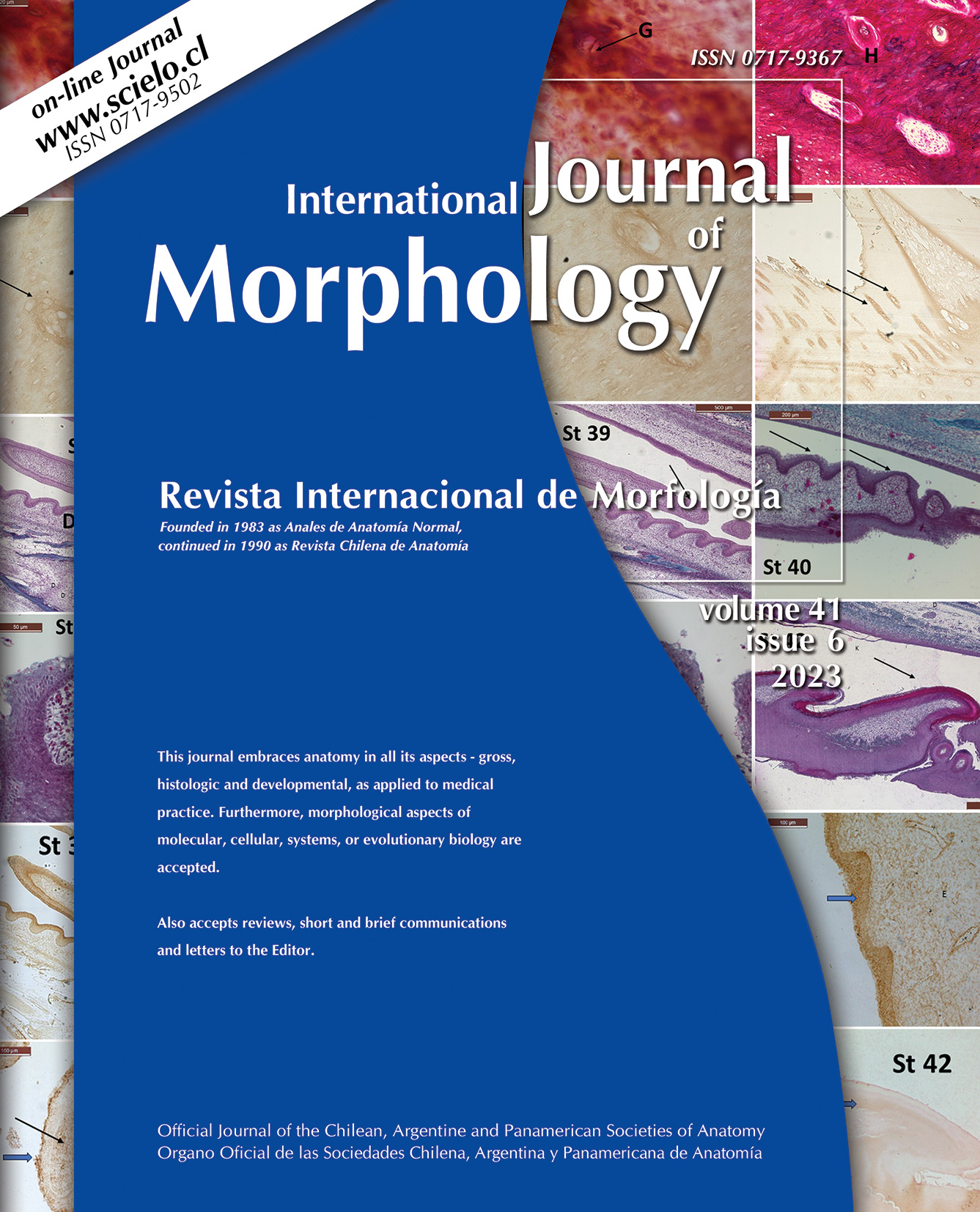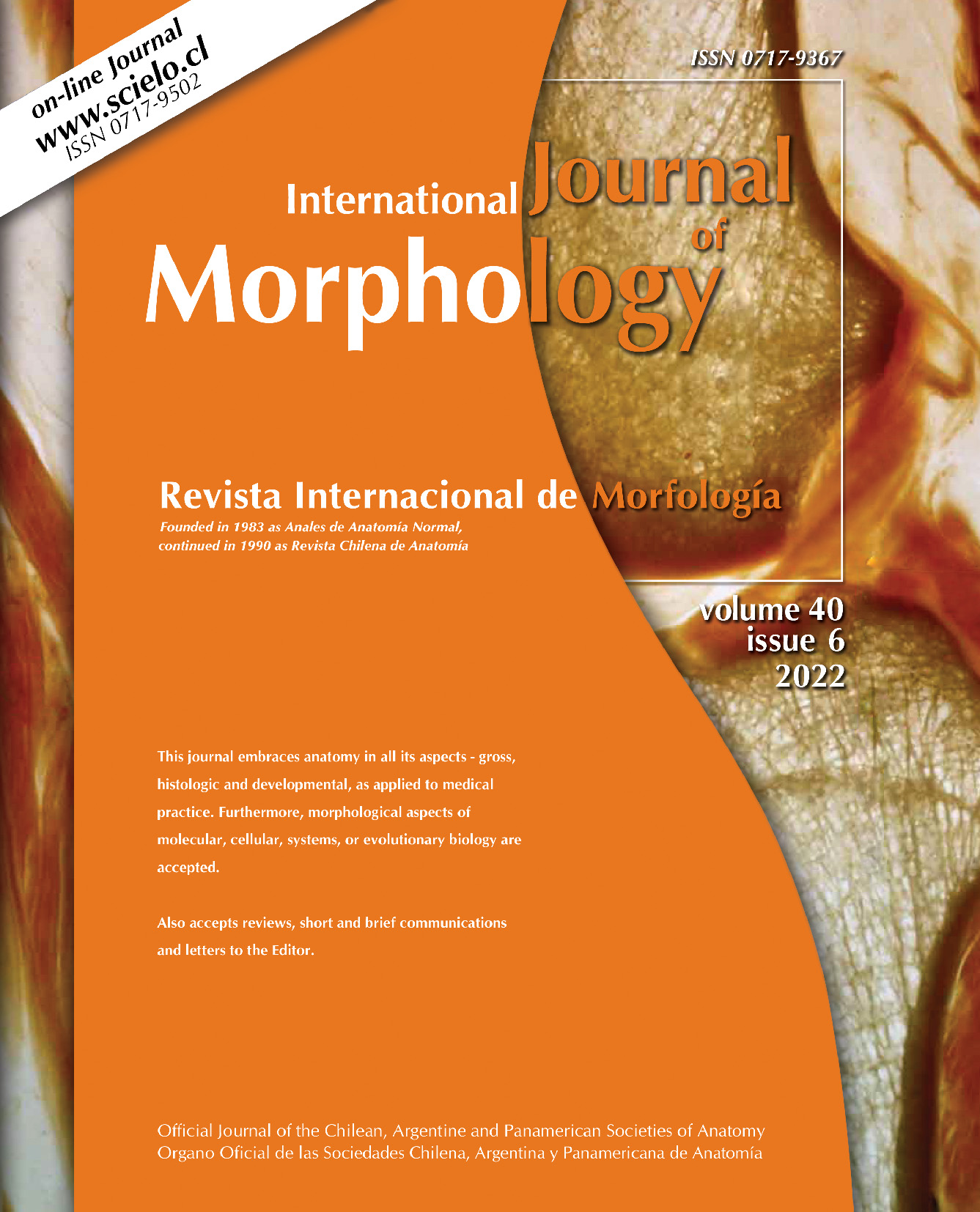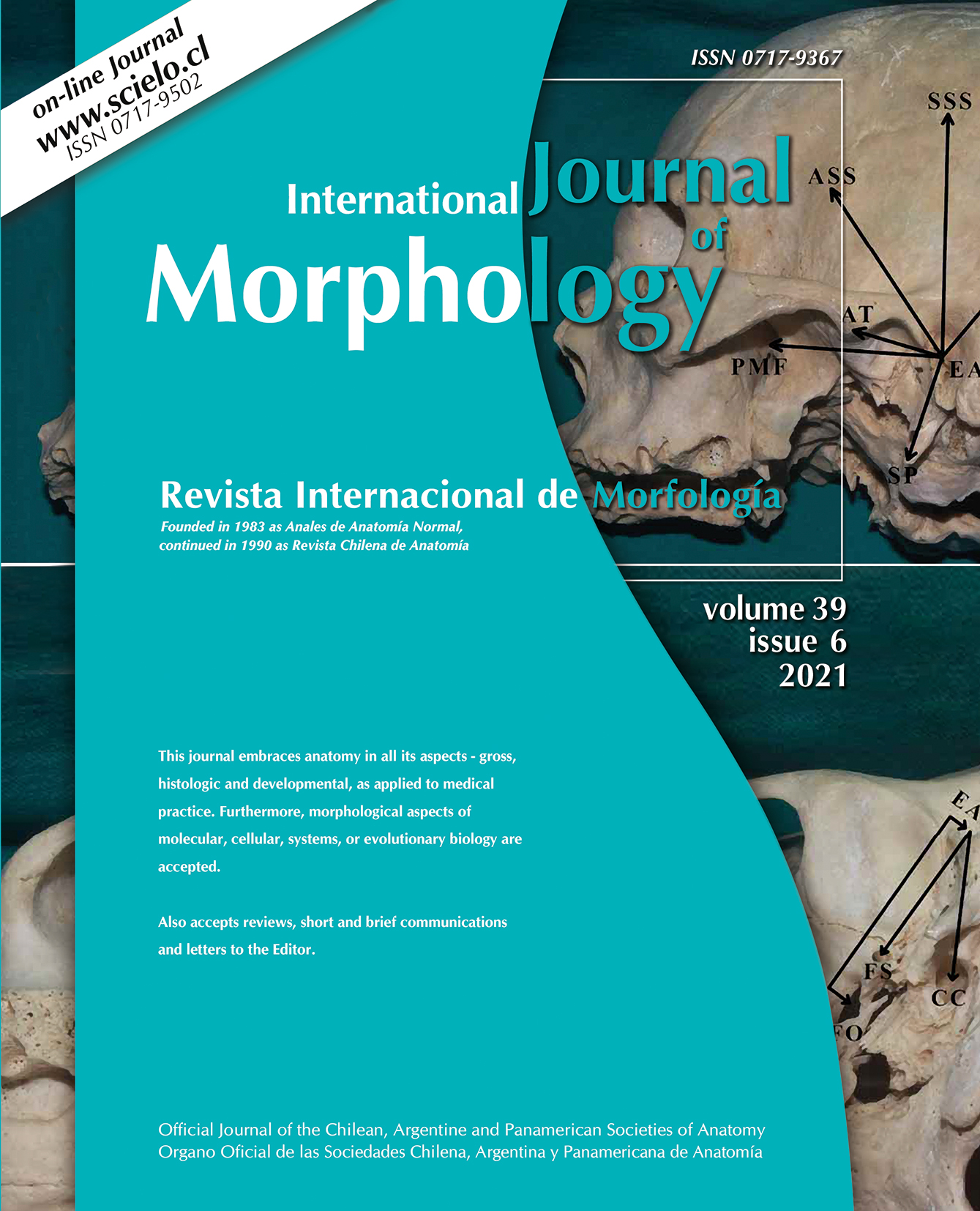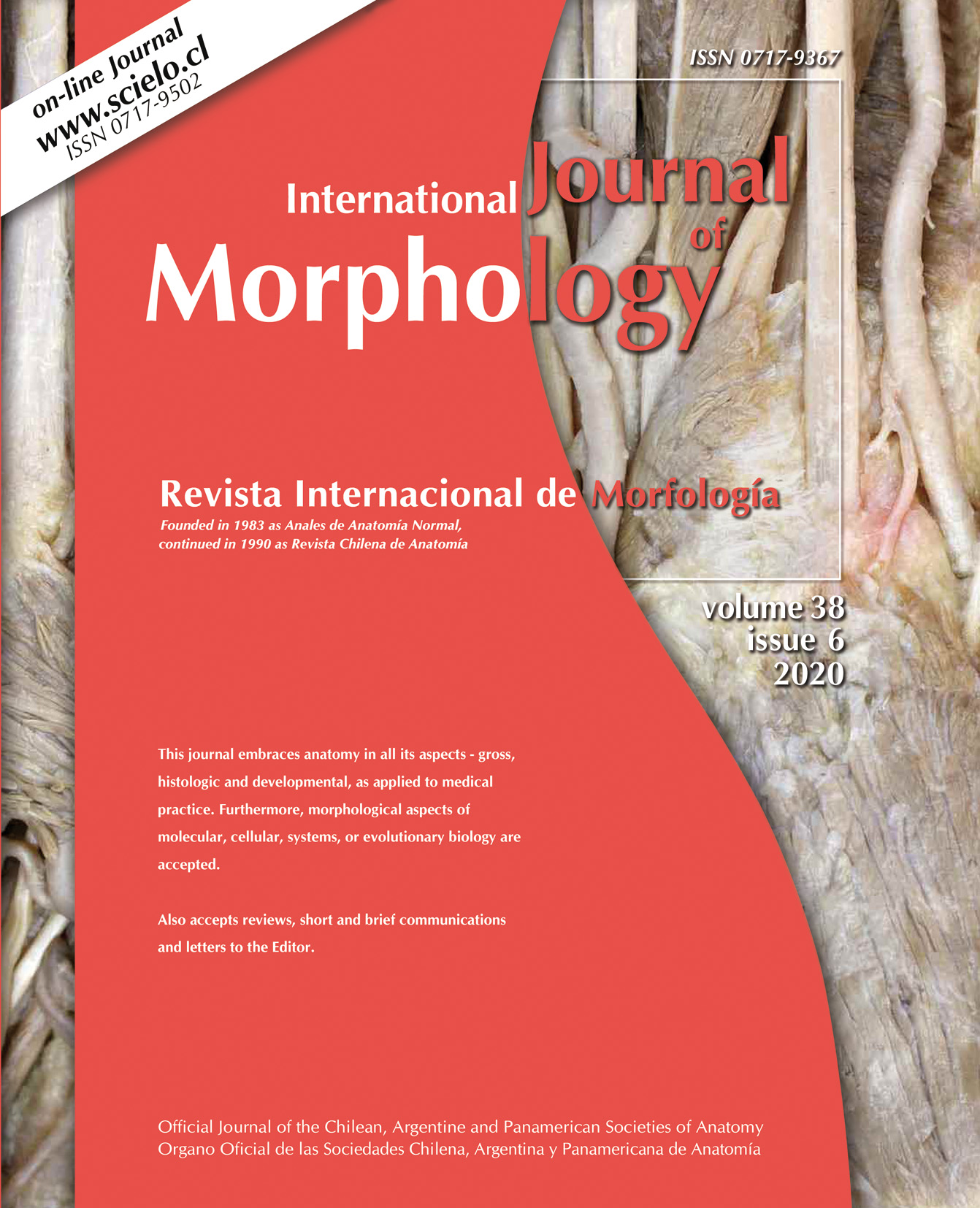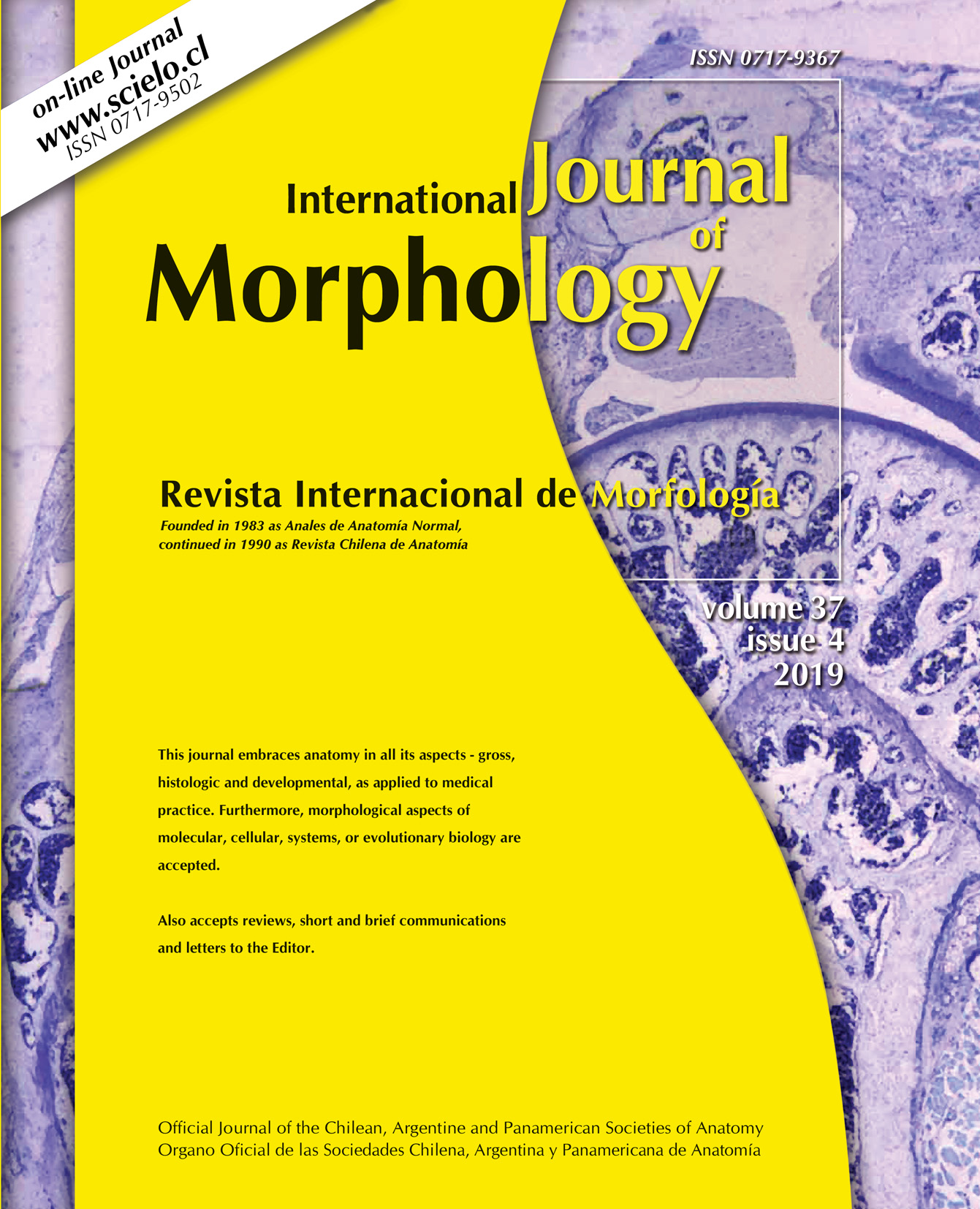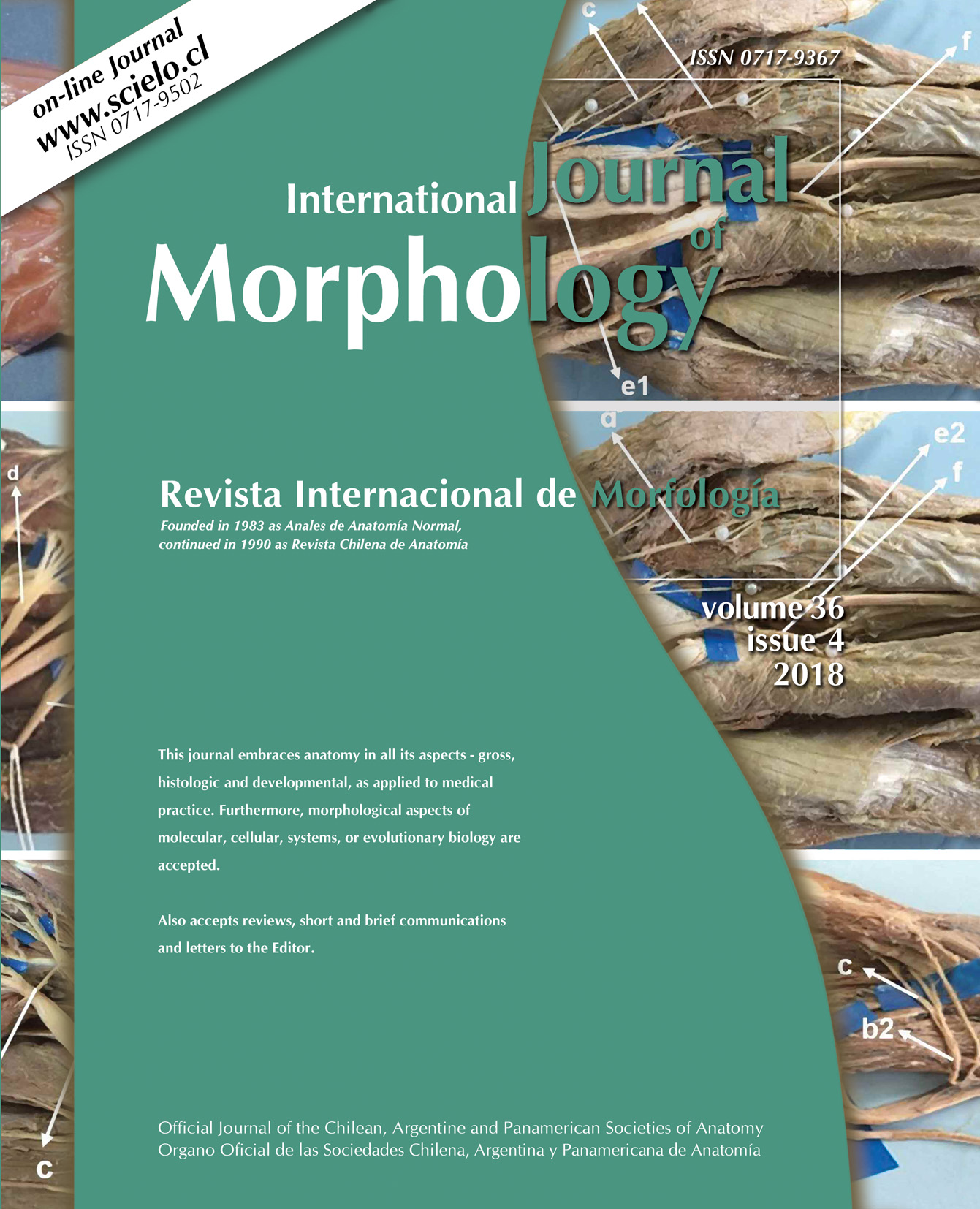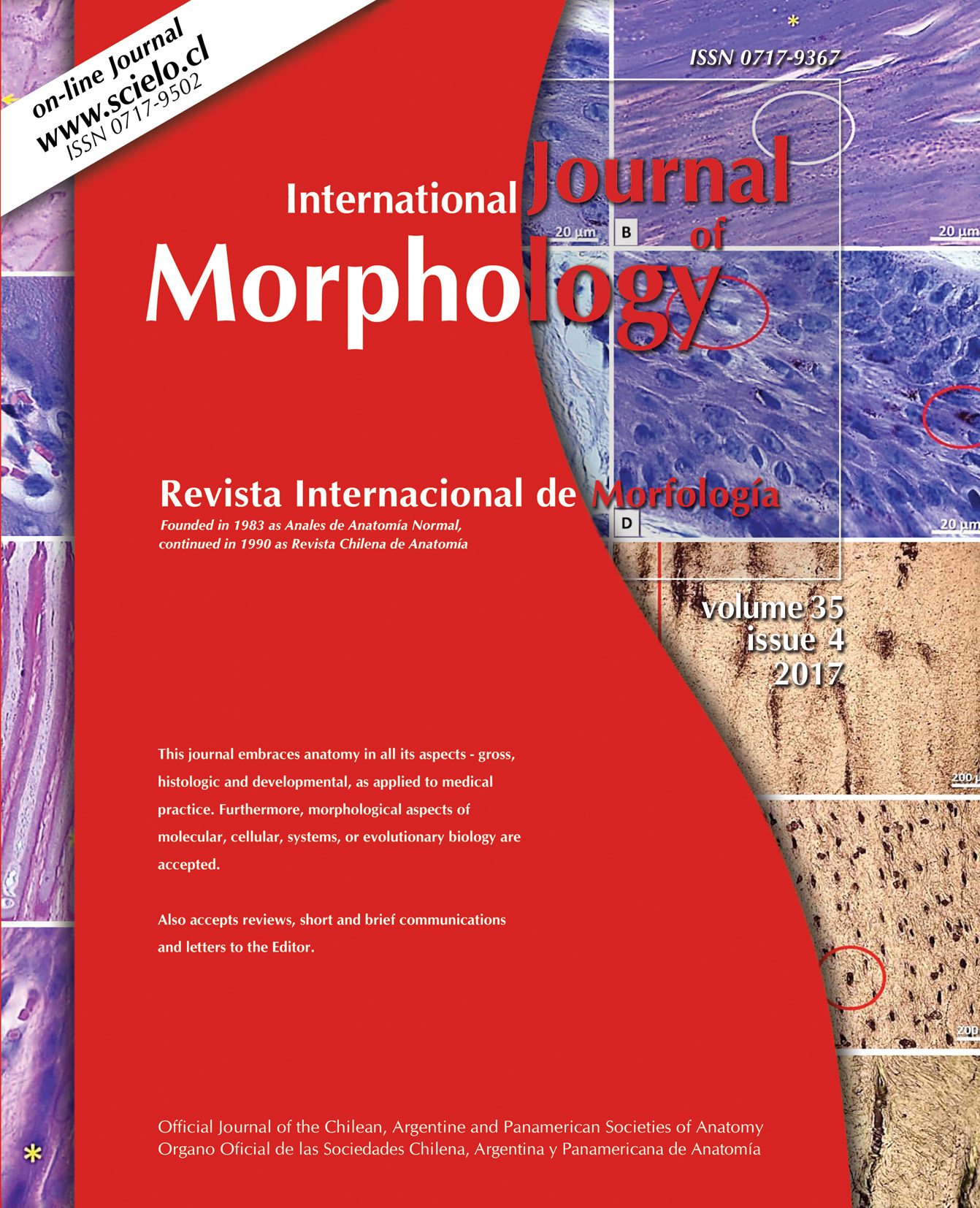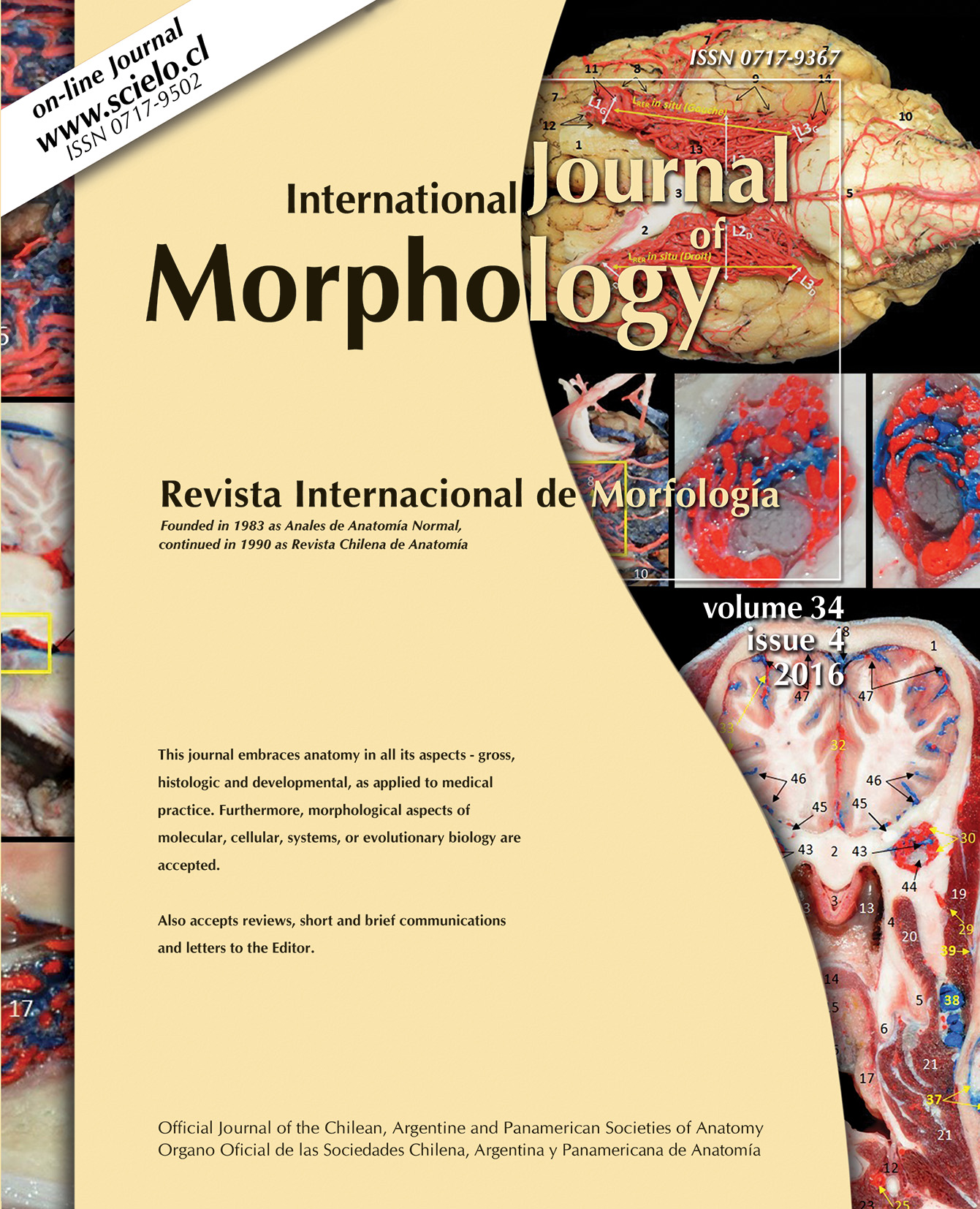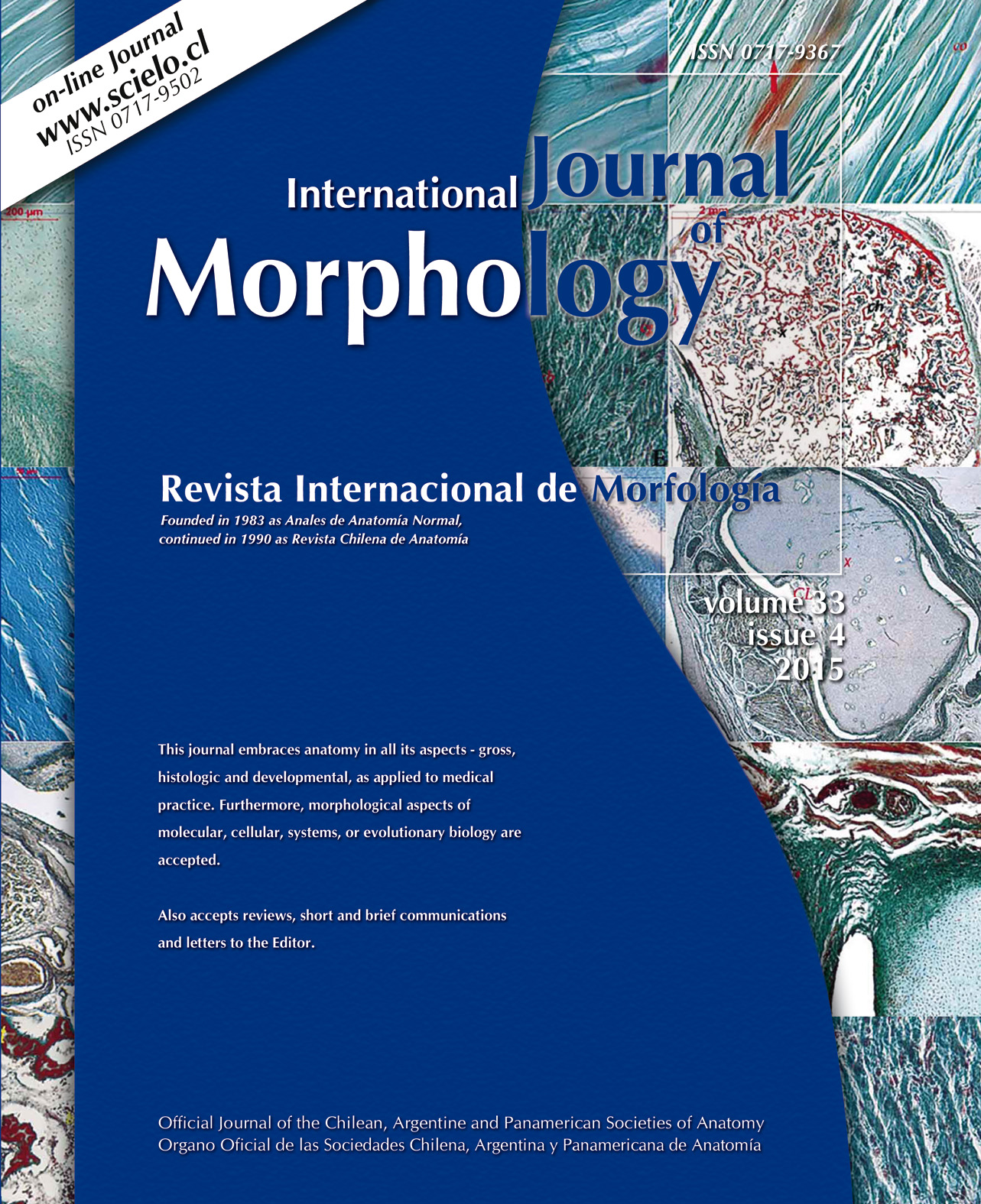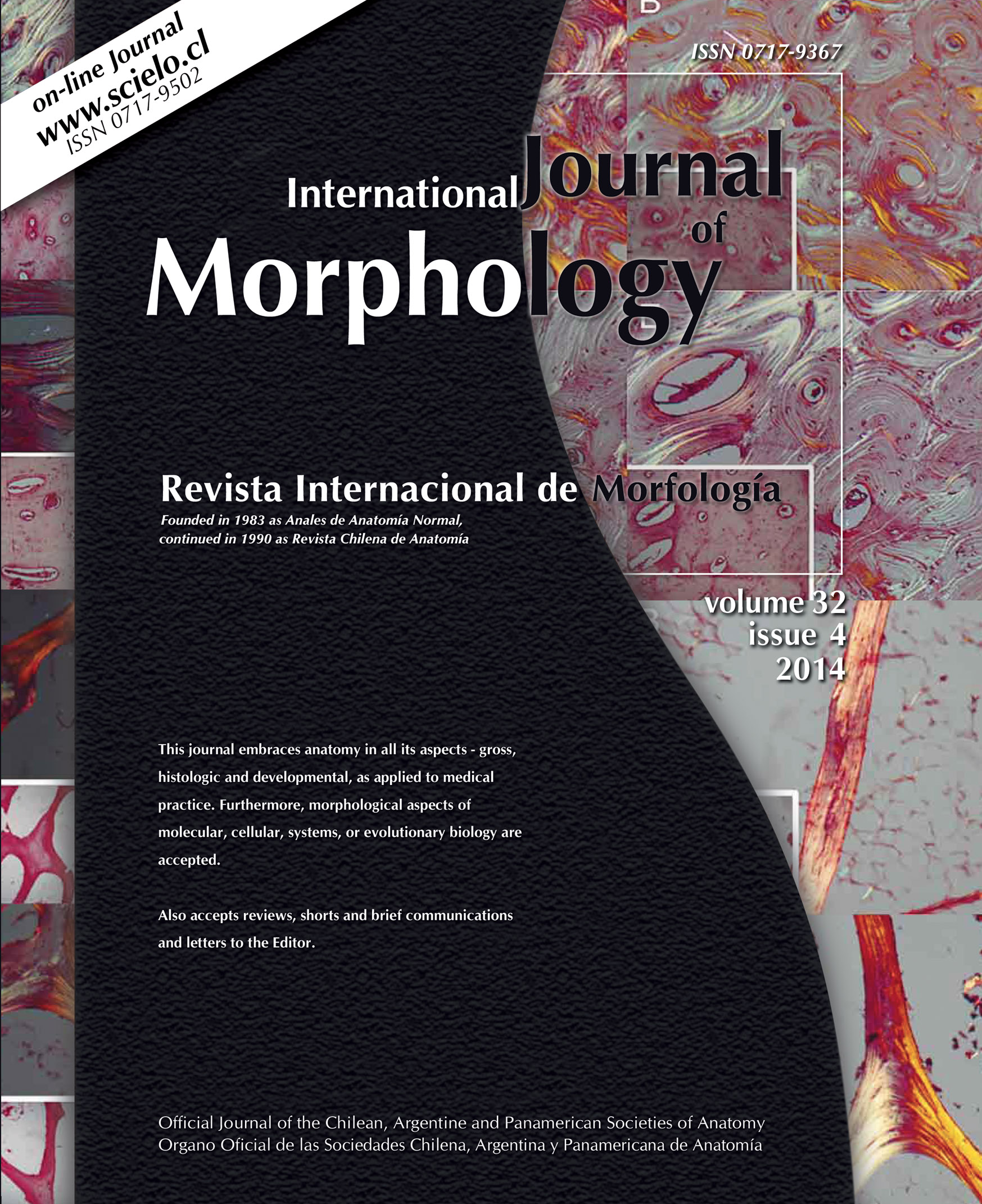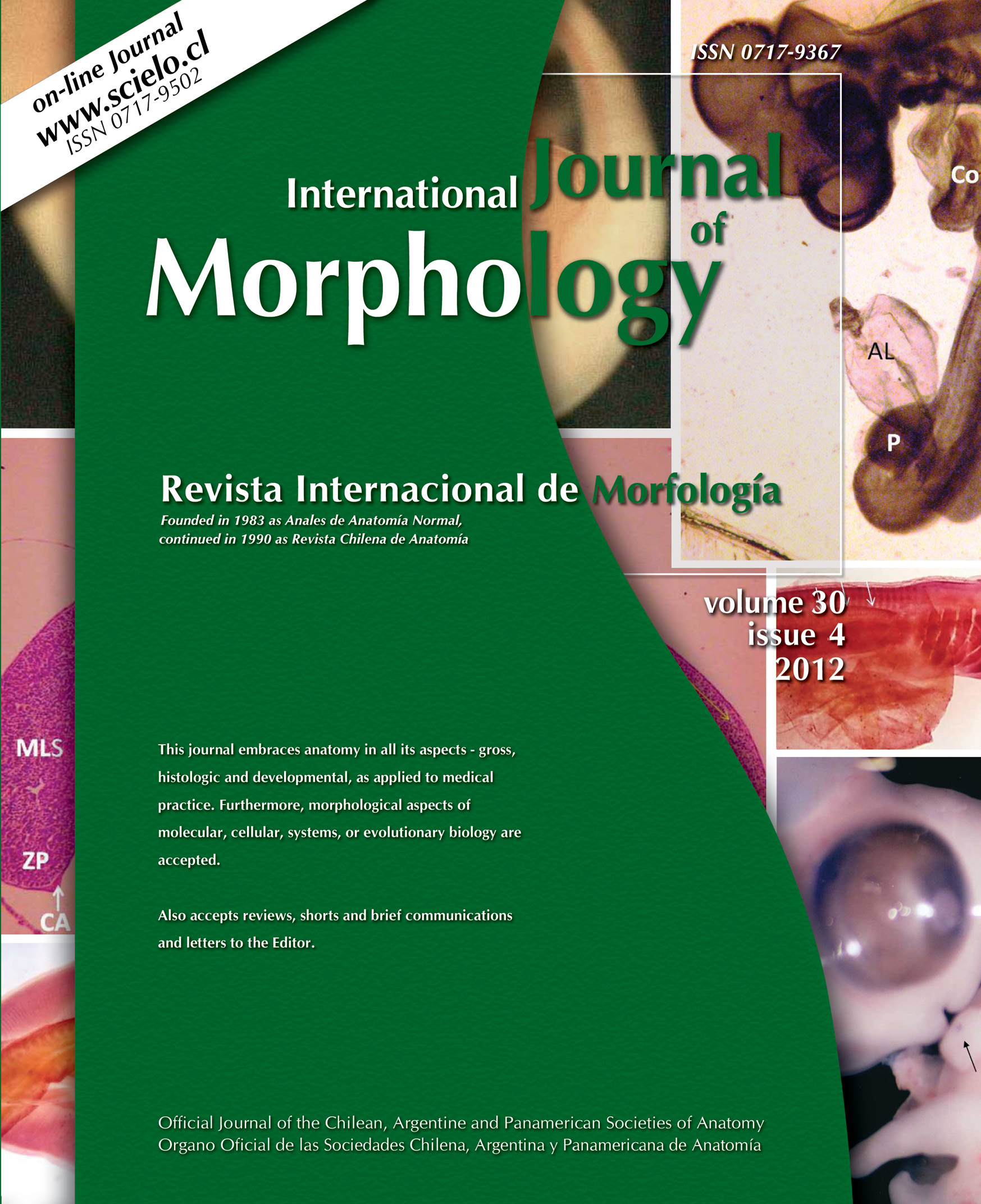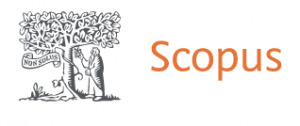INSTRUCTIONS TO AUTHORS
Scope and policy
|
CATEGORIES OF MANUSCRIPTS CONSIDERED FOR PUBLICATION International Journal of Morphology (Revista Internacional de Morfología) (Print ISSN 0717-9367; Online ISSN 0717-9502) is an official publication of the Chilean Society of Anatomy, Argentine Association of Anatomy and Pan American Association of Anatomy. It is the continuation of Revista Chilena de Anatomía (Chilean Anatomical Journal) and is published bimonthly. The six issues published yearly constitute one volume. This journal covers morphology in all its aspects of Normal and Experimental Morphology, Gross Anatomy, Histology, Embryology and Developmental Biology, as well as human and animal morphological aspects, including Celular Biology, Molecular Biology and Evolutionary Biology. All documents submitted to International Journal of Morphology must be original (articles, reviews, letters to the editor, brief communications and withdrawn publications, among others). The sending of the document must be accompanied by a letter signed by all the authors, it should be expressly declared that the manuscript must be approved by all authors, may not have been published or previously sent either in full or a part thereof, and may not be under consideration by any other journal. All authors of manuscripts submitted should complete the “Author Responsibility Statement” form which is in accordance with the recommendations of the International Committee of Medical Journal Editors (www.icmje.org), regarding authorship criteria. For authors from countries whose language is different from English, an English translation certificate of the manuscript, issued by a native English translator or by a translation services company, must also be attached. |
Compliance with ethical standards
|
To guarantee objectivity and transparency in the investigation and to ensure that the accepted principles of ethical and professional conduct have been followed, in studies on human beings and experimental animals, the authors must submit copies of the research approval document issued by the Scientific Ethics Committee of the Institution. In research on human beings, the International Journal of Morphology reserves the right to request informed consent In addition, the authors must include information on sources of financing and possible conflicts of interest, using a form available on the website of the International Committee of Medical Journal Editors (www.icmje.org) (“Uniform Disclosure Form for Possible Conflicts of Interest”). Ethical guidelines according to study subject A. Research in Humans Any research involving human participants must have been approved by the Scientific Ethics Committee, and must have been conducted in accordance with the principles expressed in the Declaration of Helsinki. The authors must submit, upon request, a statement from the Institutional Review Board or an equivalent Ethics Committee indicating the research’s approval. We reserve the right to reject any work that we believe has not met a high ethical standard, even when formal approval has been obtained. Subjects must receive proper instruction, and consent their participation by signing the appropriate informed consent document. If the consent was verbal rather than written, or if it could not be obtained, the authors must explain the reasons in the manuscript, and the use of verbal consent or lack of consent must have been approved by the Institutional Review Board or equivalent Scientific Ethics Committee. All efforts should be made to protect the patient’s privacy and anonymity. Identifying information, and photographs, should not be included in the manuscript unless that information is crucial and the person has given written consent. More information about patient privacy, anonymity and informed consent can be found in the International Committee of Medical Journal Editors website (www.icmje.org) (“Privacy and Confidentiality Guidelines”). The Material and Method section of the article on research using human subjects or samples must include ethical statements that specify the following:
Studies involving donated human bodies should be acknowledged in the acknowledgments of the article (Iwanaga et al. Acknowledging the use of human cadaveric tissues in research papers: Recommendations from anatomical journal editors. Clin. Anat. 2021, 34(1):2-4). B. Research in Animals All research involving vertebrates or cephalopods must have the approval of the Institutional Review Committee or equivalent Scientific Ethics Committee, and must have been conducted according to the National and International guidelines that apply. Approval must be received before beginning of the intervention. Manuscripts reporting on animal research should be included in the Material and Method section:
Example of an ethical statement: This study was conducted in strict accordance with the recommendations of the National Institutes of Health’s Guide for the Care and Use of Laboratory Animals. The research protocol with animal experimentation was approved by the Scientific Ethics Committee of University XXXXX (Protocol Number: 00-0000). All surgery was performed under sodium pentobarbital anesthesia and every effort was made to minimize suffering. Humanitarian Endpoint Manuscripts reporting on studies in which the death of an animal (vertebrate, cephalopod) is a probable outcome or a planned experimental endpoint, must provide detailed information on the details of the study design, the rationale for the approach and methodology, including consideration of humanitarian endpoints. This applies to research involving, for example, the evaluation of survival, toxicity, longevity, terminal illness, or high incidental mortality rates. Definition of humanitarian endpoint A humanitarian endpoint can be defined as “the earliest indicator of (possible) pain and/or suffering in an animal experiment that, within a context of moral justification and scientific endpoints to be achieved, can be used to avoid or limit pain and/or suffering by acting with measures, such as humanitarian sacrifice or relief from pain and suffering” (Hendriksen & Morton, 1999). Please refer to the NC3Rs guidelines for more information. |
|
The manuscripts will be subject to evaluation by the Editing Committee and the Scientific Council. The review will be carried out by two evaluators, members of the Editing Committee and/or the Scientific Council, and ad hoc advisors specialized in the field of study of the article. The specialists in the subject matter will determine if the article may a) be published; b) be published with modifications or c) is rejected. A copy of the determination will be sent to the corresponding author. |
Form and preparation of manuscripts
|
FORM Manuscripts should be as concise as possible (no more than 12 pages long, including text, illustrations, and References). The manuscript should be prepared in Word format, in letter-size, use Arial font, size 10, spaced 1.15 pt, with a 3 cm margin. Manuscripts must be sent by email (Text and Tables in separate word format and Figures in jpg format, at least 300 dpi and in separate files). Only manuscripts written in English and Spanish will be considered. They should be organized as follows: Title Page, Summary and Key Words, Introduction, Material and Method, Results, Discussion, Conclusions, Acknowledgments, and References. The summary and key words translation to Spanish will be realized by the journal. Each article must present:
Abbreviations used in figures should be defined in the legend and must match exactly those used in the text. If necessary, use letters, numbers or transferable symbols.
Follow these examples: Al-Talalwah, W. The inferior epigastric artery: anatomical study and clinical significance. Int. J. Morphol., 35(1):7-11, 2017. In text: Al-Talalwah (2017) Kopuz, C. & Ortug, G. Variable morphology of the hyoid bone in Anatolian population: Clinical implications – A cadaveric study. Int. J. Morphol., 34(4):1396-403, 2016. In text: Kopuz & Ortug (2016) Castrogiovanni, P.; Mazzone, V. & Imbesi, R. Immunolocalization of HB-EGF in human skin by streptavidin-peroxidase (HRP) conjugate method. Int. J. Morphol., 29(4):1162-7, 2011. In text: Castrogiovanni et al. (2011) Standring, S. Gray’s Anatomy. The Anatomical Basis of Clinical Practice. 41st ed. New York, Elsevier, 2016. Nomenclature. The terminology should be used according to the last edition of Terminologia Anatomica, Terminologia Histologica, Terminologia Embryologica, Terminologia Neuroanatomica, Nomina Anatomica Veterinaria or Nomina Anatomica Avium. The terms in Latin can be translated into the native language (English or Spanish). Abbreviations or symbols. Must conform to the international scientific nomenclature. Use the International Measurement System (SI). Cost of publications: Articles in black and white cost = USD 500. Authors are encouraged to submit color illustrations when the color conveys essential scientific information. Color reproduction will be subsidized by the publisher, reducing author costs to USD 200 per page. Corresponding author
Pre-publication:
Post-publication: Continue to be the point of contact for inquiries about the published article. Inform all co-authors of any issues that arise and ensure they are dealt with promptly. Changes in authorship International Journal of Morphology follow COPE “Guidelines for Changes in Authorship” (https://publicationethics.org/). Changing the list of authors after submission requires the agreement of all authors. This includes additions, deletions, and changes in order. Requests must come from the corresponding author along with an explanation of the change. If the change is deemed appropriate, the corresponding author should receive and provide International Journal of Morphology with consent for the change from all authors, including additions, deletions, or rearrangements. Authorship problems identified after publication may result in a correction. In the event of an authorship dispute, the journal will not arbitrate. If the authors cannot resolve the dispute themselves, we will raise the issue with the authors’ institutions and carry out according to their guidelines. Cover letter format Dear Editor Please find attached the research article entitled, “_ _ _ _ _ _ _ _ _ _ _ _ _ _ _ _ _ _ _ _ _ _ _ _ _ _ _ _ _ _ _ _ _ _” whose authors are “_ _ _ _ _ _ _ _ _ _ _ _ _ _ _ _ _ ” to be considered for publication in International Journal of Morphology. We believe that our work _ _ _ _ _ _ _ _ _ _ _ _ _ _ _ _ (Explain, in a paragraph, what is the original contribution and relevance of the work in the field). We wish to confirm that there are no conflicts of interest associated with this publication and there has been no significant financial support for this work that could have influenced its outcome. We confirm that the manuscript has been read and approved by all named authors and there are no other people who meet the criteria for authorship that are no listed. We further confirm that the order of authors listed in the manuscript has been approved by all of us. We confirm that we have given due consideration to the protection of intellectual property associated with this work and that there are no impediments for publication, including the timing of publication, concerning to intellectual property. In so doing we confirm that we have followed the regulations of our institutions concerning intellectual property. We further confirm that any aspect of the work covered in this manuscript that has involved either experimental animals or human patients has been conducted with ethical approval and that such approvals are acknowledged within the manuscript. We understand that the Corresponding Author is the sole contact for the Editorial process (including Editorial Manager and direct communications with the office). He/She is responsible for communicating with the other authors about progress, submissions of revisions and final approval of proofs. We confirm that we have provided a current and correct email address which is accessible by the Corresponding Author. Sincerely Yours, |
Electronic submission of manuscripts
The manuscripts should be sent by e-mail (Text and Tables in word format and Figures in jpg format at 300 dpi).
|








